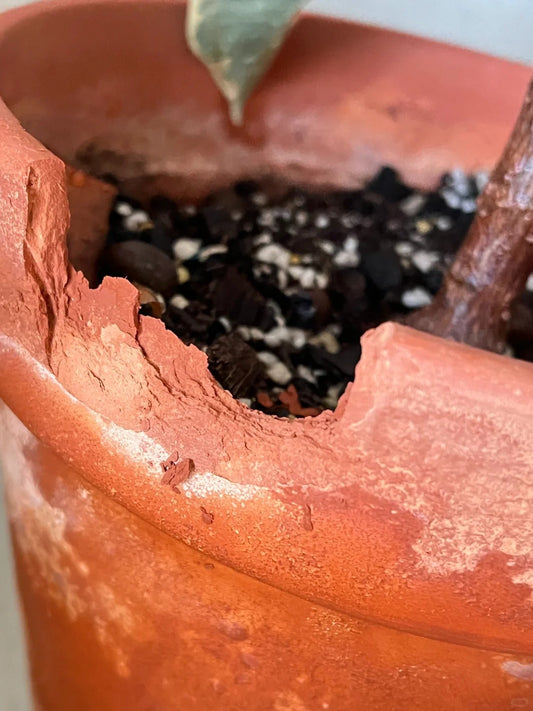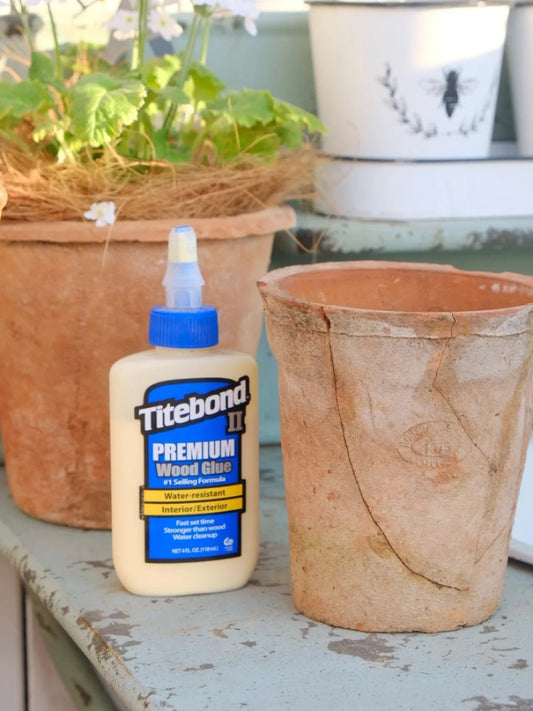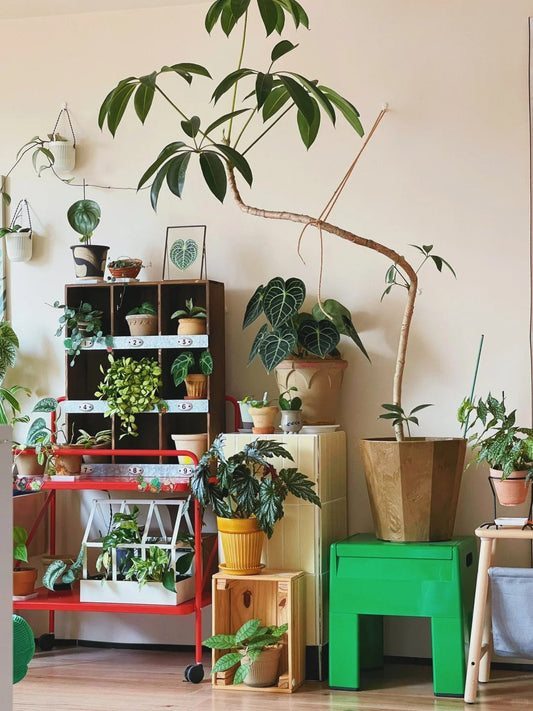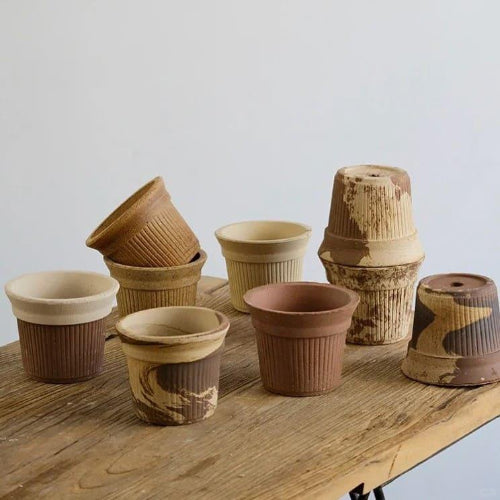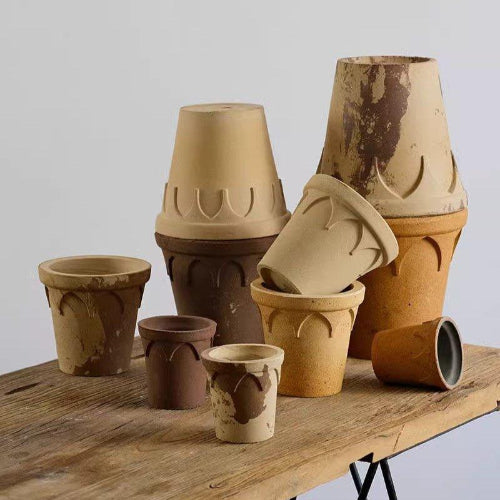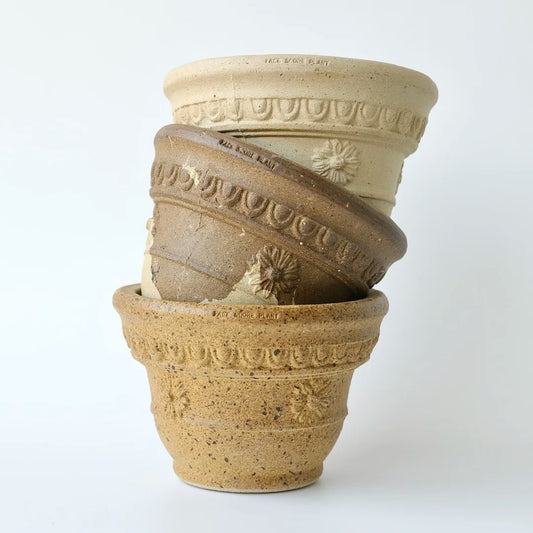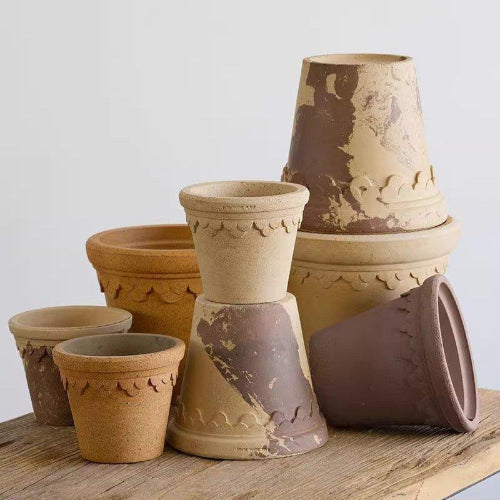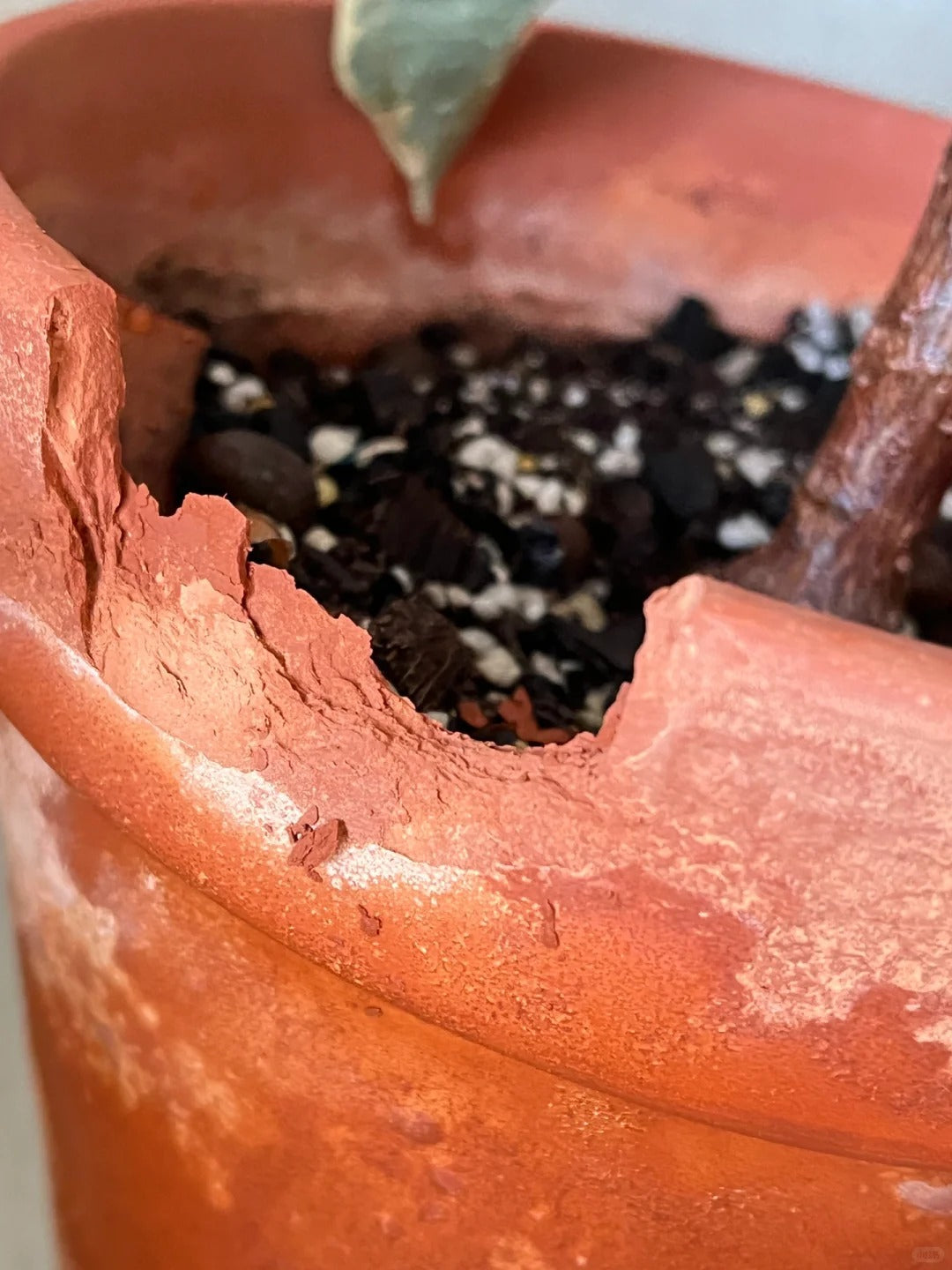
Why Terracotta Pots Flake and Weather: The Science of Clay Planters
Terracotta (Italian for “baked earth”) is a low-fired earthenware clay prized for its warm color and breathability. Unlike high-fired stoneware or porcelain, terracotta never fully vitrifies in the kiln. It is typically fired at only 950–1100 °C. This leaves the clay body relatively soft and porous – often 5–15% pore space – so it will freely absorb water. A typical terracotta mix might be roughly 50–60% silica, 10–20% alumina, and 5–8% iron oxide (which gives the red color), with a few percent fluxes like lime or potash to help it mature. The combination of these minerals makes terracotta hard yet friable: it has plenty of microscopic holes that hold moisture. In practical terms, an unglazed clay planter or flower pot will soak up soil moisture and dissolve small amounts of its own minerals over time.
These material properties are a double-edged sword. The porosity helps plants by wicking water from the soil and evaporating it to cool roots, but it also means the surface is vulnerable to degradation. Water (especially if it contains dissolved salts or fertilizer) penetrates deep into the pot wall. When that water later evaporates, it can leave behind minerals on the surface. This leads to the common white, chalky residue and crusts seen on outdoor pots. For example, one gardening guide explains that “efflorescence” on terracotta occurs when water-soluble salts are drawn to the surface of the clay as the water evaporates. Terracotta’s natural minerals (and any potting-salt or hard-water minerals) travel with the water and crystallize on the outside. Over many waterings, the buildup can become an encrusted white film or even flaking crust on the planter surface.
Outdoor clay flower pots (shown here) can develop moss, algae, and mineral stains from weather exposure. The rough, porous surface allows moisture and salts to penetrate, so rain and sprinkler water gradually weather the surface of clay planters.
Efflorescence and Mineral Buildup on Clay Pots
Because unglazed terracotta is so absorbent, minerals from soil, fertilizer, or hard water tend to accumulate on the pot walls. As one plant-care guide notes, “white mineral deposits from plant food and hard water… will build up on terra-cotta” over time. In plain terms, dissolved salts (often calcium, magnesium, or other minerals) creep through the clay with each watering. When the water evaporates, it leaves those salts behind. This is exactly what efflorescence is: a white, powdery, or crusty salt deposit. The process is harmless to the clay itself at first, but it can make the surface flake if the crystal growth lifts tiny grains of clay out of the pot.
In addition to water-soluble salts, residual minerals from the clay’s manufacturing can also emerge. New terracotta often contains traces of soluble compounds left from its firing process. The first few saturations of water may pull out these residues, causing initial white flakes. After that, the main cause is usually the salts in the potting mix or irrigation water. For example, a Florida extension service explains that “salts from hard water and fertilizers can leach through clay pots, leaving a white film on the pot’s outer surface. Salts accumulation can become flaky and encrusted around the rim and drainage holes”. In other words, chlorine, calcium, or sodium in tap water (especially in hard-water areas) will slowly clog the pores and show up as white or gray deposits.
These mineral films not only look unsightly, but they can sometimes stress plants. A Better Homes & Gardens article warns that heavy mineral buildup can even sap water from the soil, potentially dehydrating plant roots. (You might notice green algae and salt deposits living side-by-side on an abandoned pot.) To reduce this effect, gardeners often recommend using well-draining mixes, flushing pots with fresh water occasionally, or even using distilled water for sensitive indoor plants. Allowing a clay pot to dry thoroughly between waterings also helps prevent salts from continually cycling through the surface.
Efflorescence on terracotta pots often looks like white or green crusty stains. These old stacked clay pots show green algae and mineral crusts. Such buildup comes from water (soil moisture, rain, or hard tap water) seeping into the porous clay and depositing salts as it dries.
Freeze–Thaw Cycles: Winter Damage
One of the most dramatic causes of flaking is freezing. Because terracotta readily soaks up water, a cold snap can literally split a pot apart. When liquid water trapped in clay pores freezes, it expands by about 9%. That expansion exerts enormous pressure on the surrounding ceramic matrix. Over time, repeated freeze–thaw cycles make cracks form and grow. An extension bulletin explains that “water in the microscopic pores of the clay expands as it freezes, resulting in slabs of pottery flaking away from the outer sides of the pot”. In practice, you’ll often see long hairline cracks starting at the rim or sides of a frozen pot, or even chunks of rim chipping off, especially if the pot was full of damp soil.
Unglazed clay flower pots are especially vulnerable in winter. Glazed ceramics shed water, but bare clay absorbs it. One master-gardener guide warns that “unglazed terracotta pots are the most vulnerable” to frost, since they let rain and moisture ing. Even a mild freeze can widen pores and flake the surface (a process called “spalling”). In regions with freeze–thaw swings, clay planters left outdoors will eventually develop rough, flaky patches or even split. (This is less of a concern in indoor gardens or warm climates, but any pot brought outside for summer can face it.) In short, if a pot holds moisture and then freezes solid, you can expect physical crumbling or peeling of its surface.
Environmental Exposure: Sun, Rain, and Overwatering
Beyond just freezing, ordinary weather also contributes. Sun, rain, and humidity produce cycles of wetting and drying that stress terracotta. Hot sun can rapidly dry a pot after rain or watering, drawing water (and dissolved minerals) outward to the surface. In very dry or arid conditions, this evaporation is especially fast, which can accelerate salt deposition. Over years of sun exposure, the color fades and the clay surface becomes more brittle – tiny fissures may develop from thermal expansion (clay expands when hot, contracts when cool). Similarly, driving rain or sprinkler sprays continuously add moisture that soaks into the pot and then sits inside until the next sunny day.
Water quality matters too. In regions with hard water, calcium and magnesium will leave permanent rings on planters. As the BHG guide notes, even garden fertilizer salts can “build up on terra-cotta, obscuring its orange hue”. Indoor gardeners should be aware of this: filling a small terracotta pot with indoor plant water will still produce white rings if the water is mineral-rich. Even without freezes, persistently wet soil or overwatering contributes to damage. Constant saturation prevents the pot from drying out and can allow algae, moss, or mold to take hold on the surface (as seen in old outdoor pots).
In summary, any external factor that keeps the clay moist or adds minerals – sun-driven evaporation, rainy weather, hard tap water, or sloppy watering practices – can gradually roughen or “weather” a terracotta planter. That’s why you often see weathered clay planters in garden displays: their chipped, chalky look is the cumulative effect of years of exposure.
Introducing Claywares: Premium Terracotta and Clay Planters
Understanding these issues highlights why Claywares emphasizes quality in our terracotta and clay planters. Each Claywares pot is fired at higher temperatures than ordinary pots, so the clay body vitrifies more fully and holds less water. This extra firing makes our planters stronger and far less porous (reducing flaking and salt buildup).
Unlike fully vitrified ceramics that trap moisture, Claywares pots retain just the right level of porosity to allow excellent water drainage and air flow. This means your plants still benefit from breathable walls that encourage healthy root systems, reducing the risk of root rot.
Whether you're looking for small terracotta pots for your indoor houseplants or large clay planters for your balcony or garden, every piece from Claywares is made with this balance in mind: strong enough to resist weathering, but still natural enough to let your plants breathe.
If you're tired of cheap pots that crack, flake, or stay soggy, Claywares offers a reliable, stylish solution for both indoor plant lovers and outdoor gardeners.
Summary
In essence, terracotta pots weather and flake because of their low-fired, porous nature. Water and salts penetrate the clay easily; as moisture dries or freezes, it causes surface crystals or cracks. Efflorescence (salty white crusts) occurs when dissolved minerals are drawn to the surface during evaporation. Freeze–thaw cycles crack and spall the clay when any absorbed water freezes. Repeated wet/dry exposure or mineral-laden water gradually erodes and stains the pot’s walls. By recognizing these causes, gardeners can take steps, such as using better-quality, high-fired clay pots, to minimize peeling and extend planter life. Ultimately, investing in a well-made clay planter (like those from Claywares) will mean far less flaking and longer enjoyment of the warm terracotta look in your garden or indoor plant collection.

